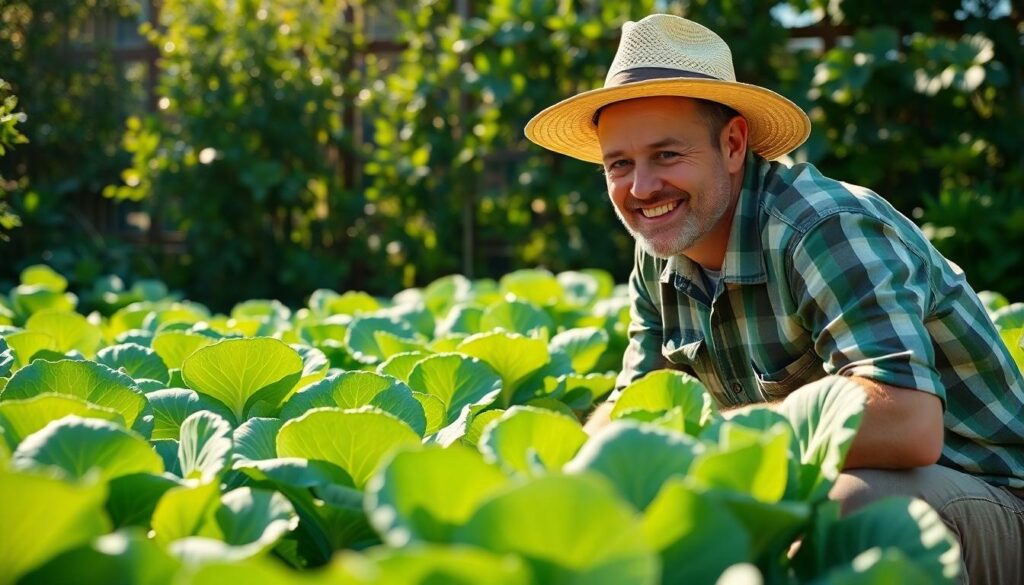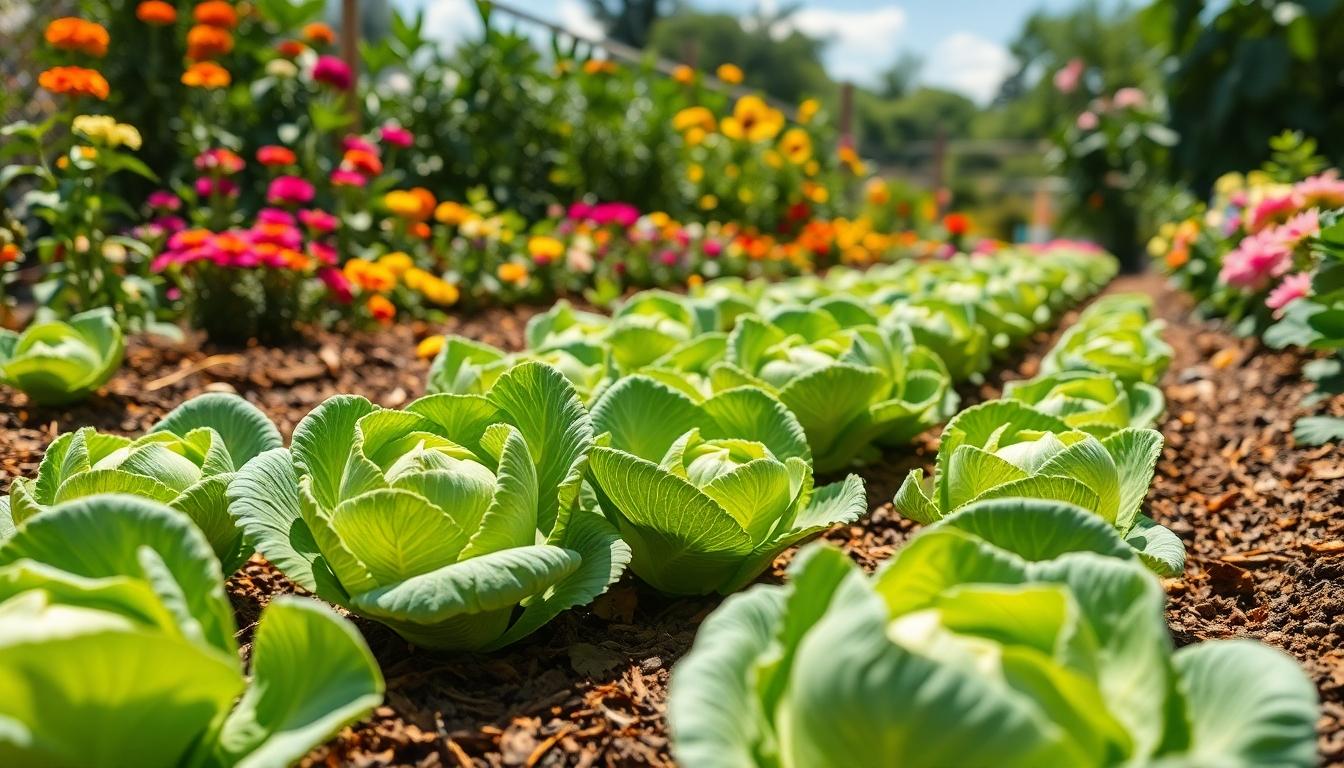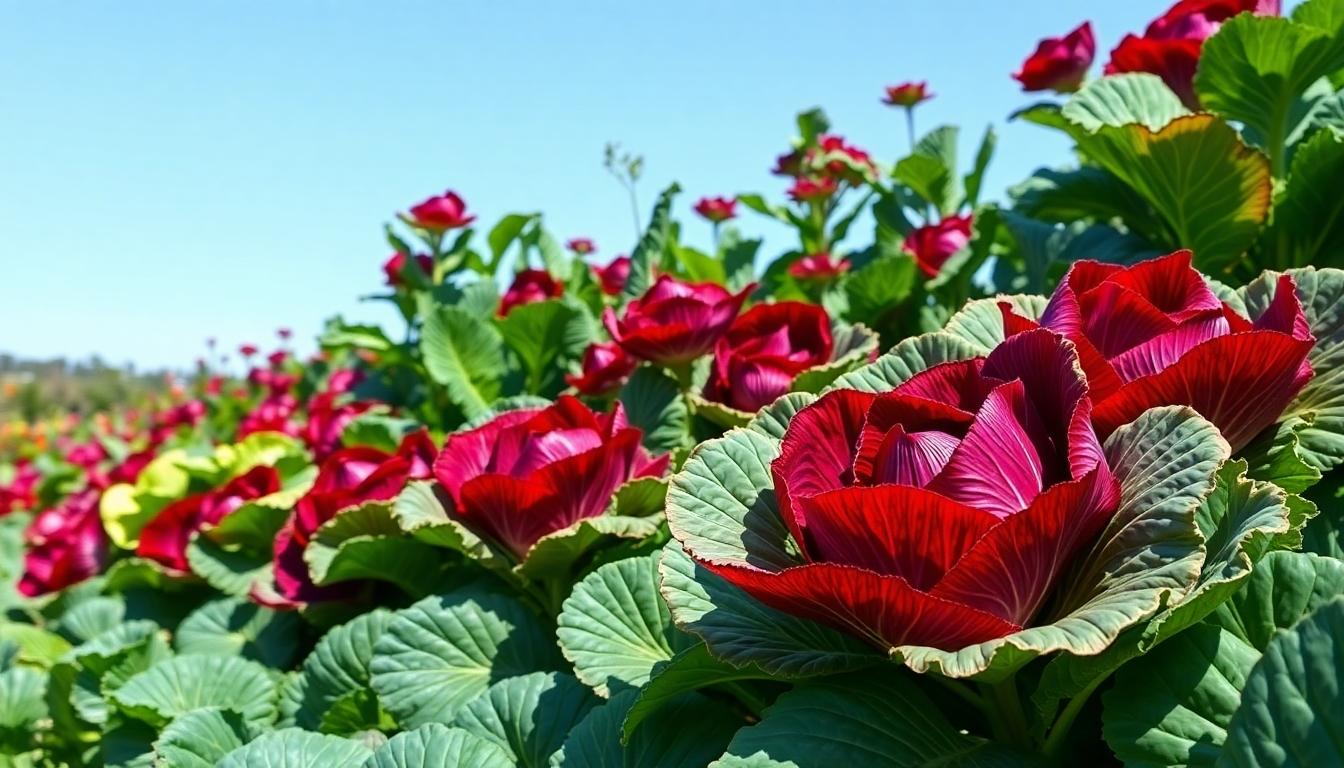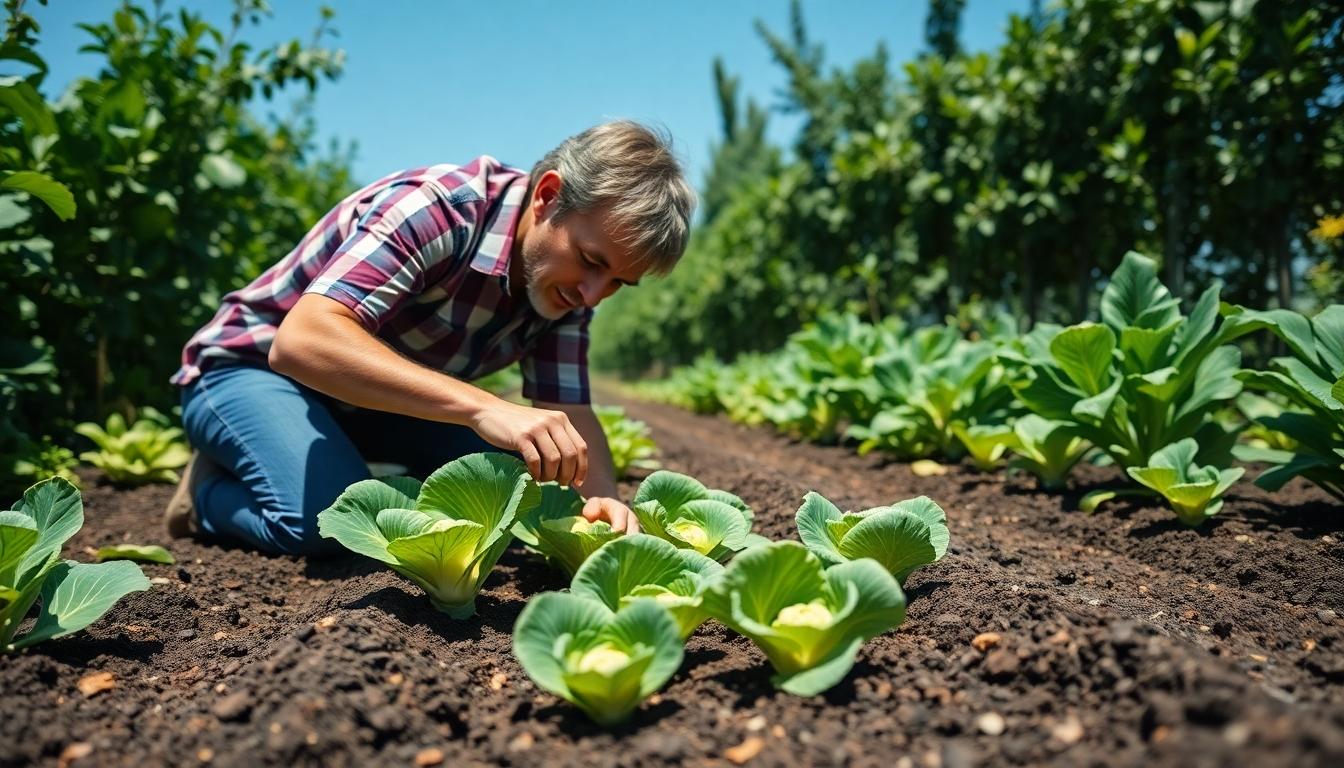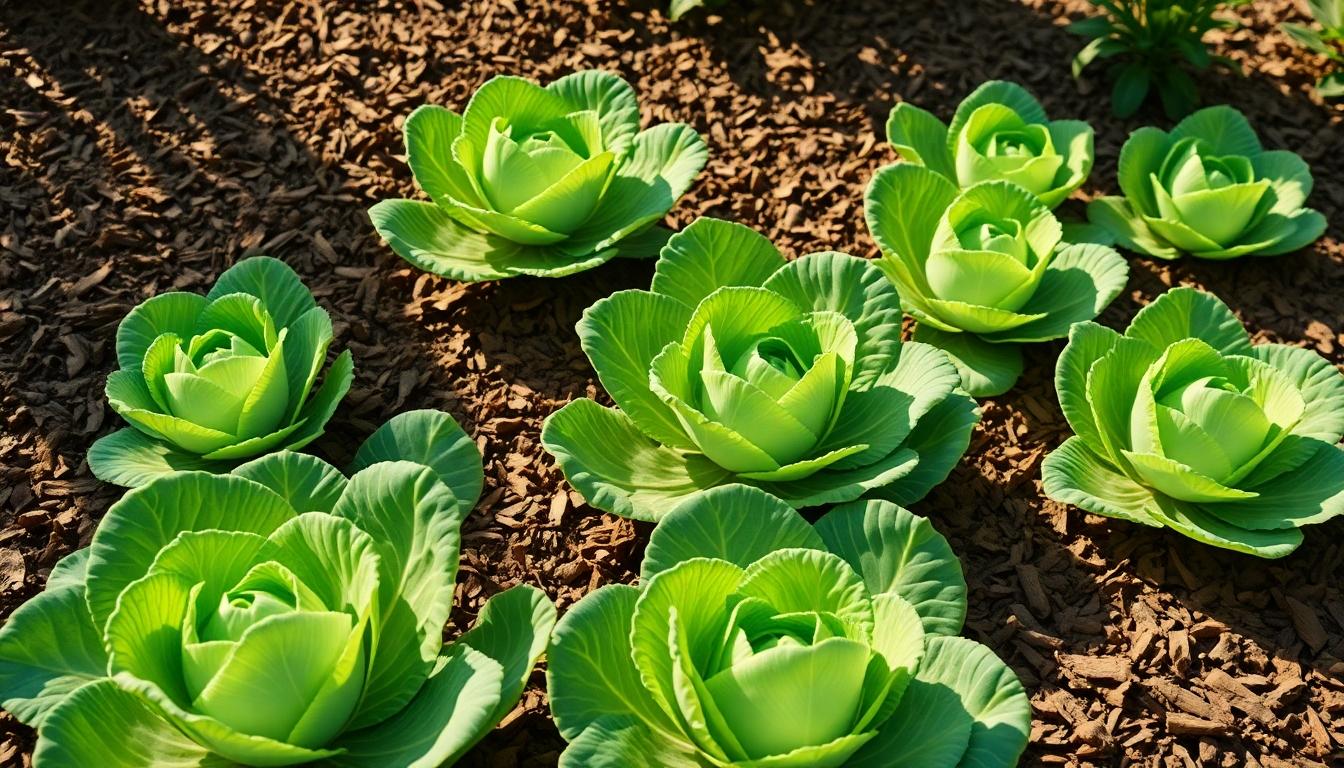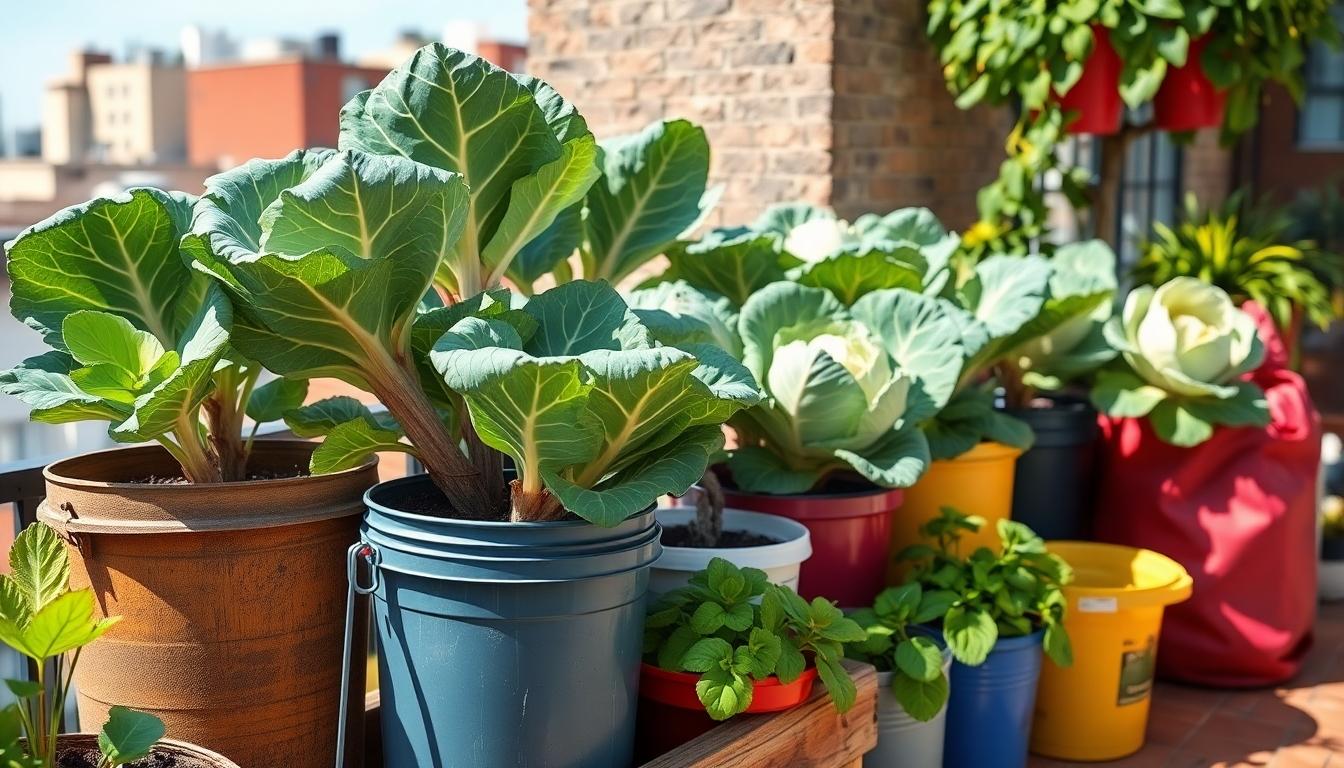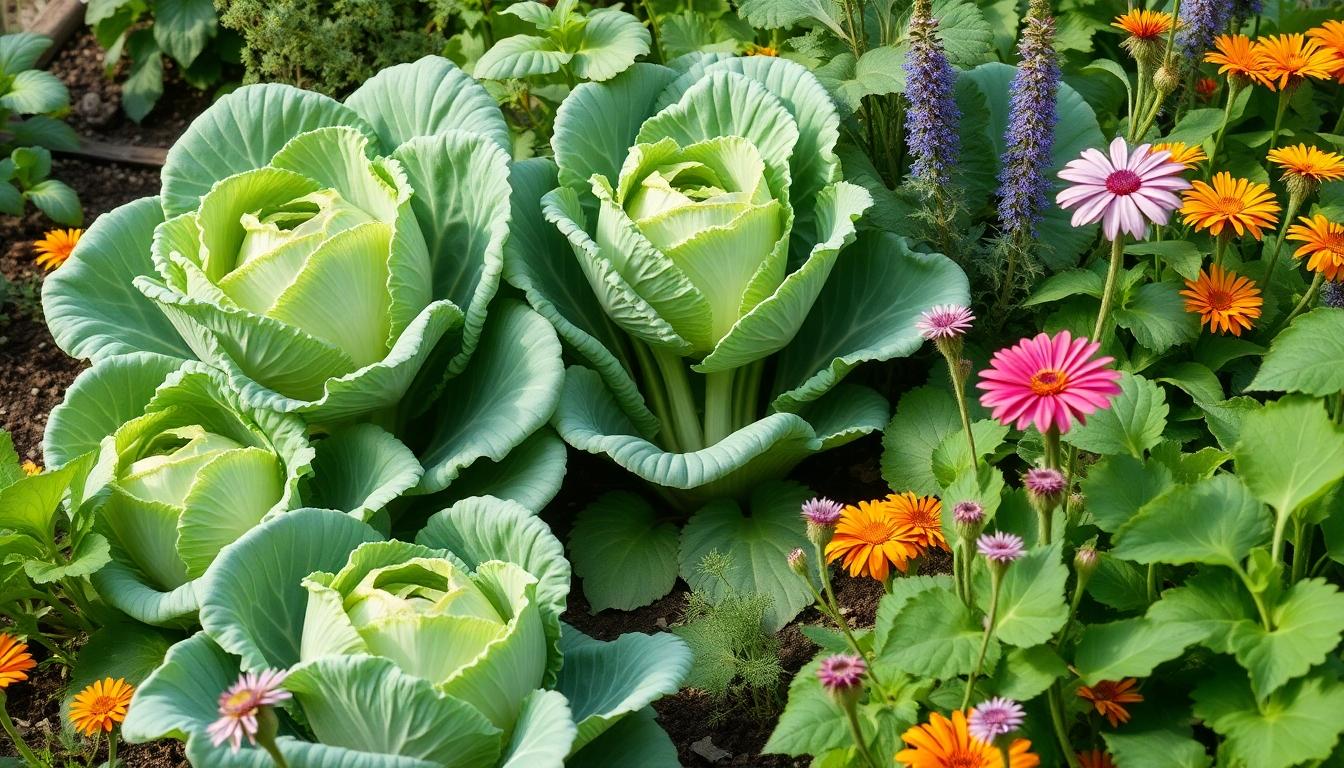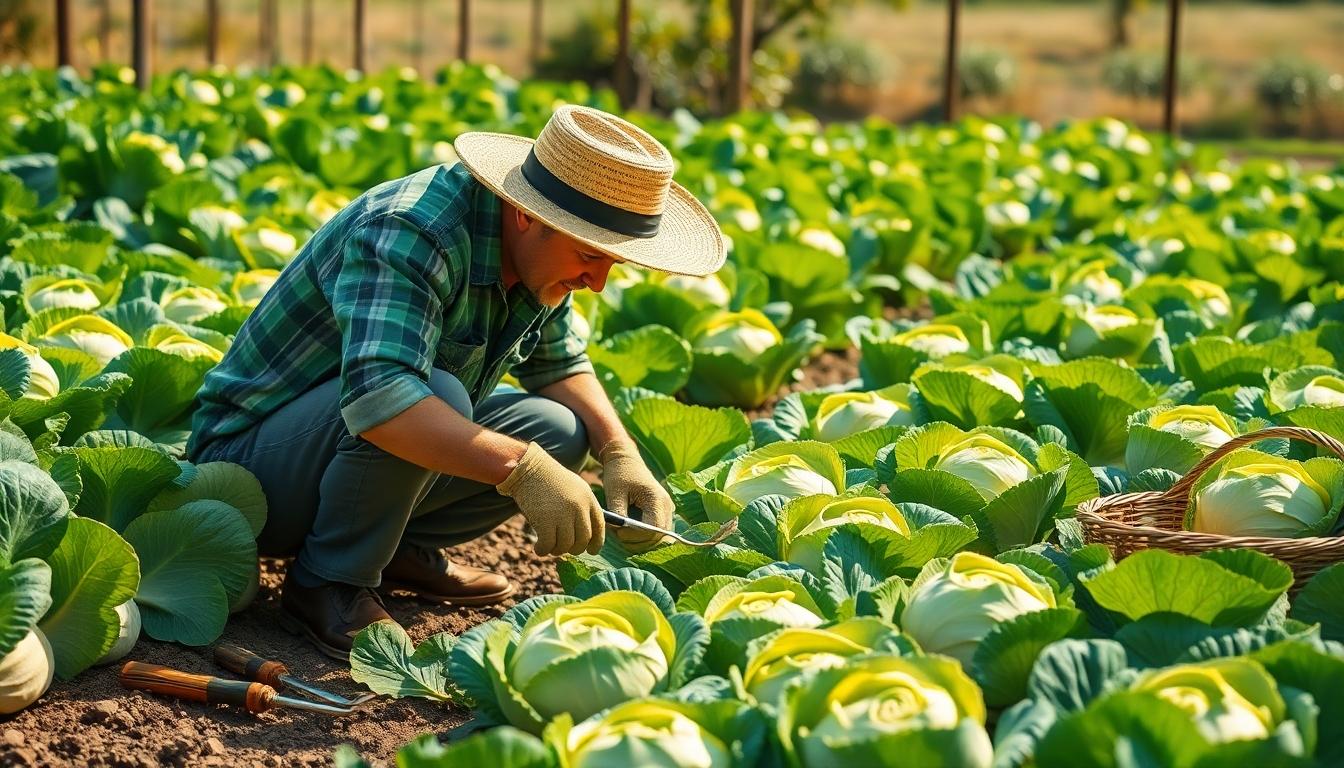Looking for a vegetable that delivers impressive yields without demanding constant attention? Cabbage might be the perfect addition to your garden. This resilient crop thrives in various conditions and rewards even novice gardeners with bountiful harvests while requiring minimal maintenance.
We’ve found cabbage to be one of the most forgiving vegetables you can grow. Its hardy nature means it’ll withstand temperature fluctuations that would destroy more delicate plants. Plus, cabbage naturally resists many common garden pests, reducing the need for chemical interventions. Whether you’re a busy gardener or just starting out, this cool-weather crop offers an excellent return on your limited time investment.
Why Cabbage Is the Ultimate Low Maintenance Crop for Home Gardeners
Minimal Watering Needs
Cabbage requires significantly less water than many other vegetables in your garden. Once established, these hardy plants need only about 1-1.5 inches of water per week, making them perfect for busy gardeners. Their deep root systems efficiently access soil moisture, reducing the frequency of watering sessions. You’ll find that cabbage plants can withstand occasional dry spells better than leafy greens like lettuce or spinach. During cooler seasons, natural rainfall often provides sufficient moisture for cabbage crops in many regions. Water conservation becomes easier with cabbage as its thick, waxy leaves help reduce evaporation compared to thin-leaved vegetables.
Natural Pest Resistance
Cabbage possesses built-in defenses against many common garden pests. The waxy coating on cabbage leaves naturally deters certain insects from feeding on the plants. Most varieties contain compounds that make them less appetizing to slugs and snails compared to other garden vegetables. You can further enhance this natural resistance by planting aromatic herbs like thyme or rosemary nearby. Beneficial insects such as ladybugs are attracted to cabbage plants and help control aphid populations without any effort on your part. Companion planting with onions or garlic creates a natural pest barrier that works continuously without chemical interventions.
Minimal Fertilizing Requirements
Cabbage thrives with modest nutritional inputs compared to hungry crops like corn or tomatoes. A single application of balanced organic fertilizer at planting time often suffices for the entire growing season. These efficient plants can extract nutrients from soil that other vegetables might leave behind. Compost added once at the beginning of the season typically provides all the nutrients cabbage needs. Many gardeners report successful cabbage harvests with no additional fertilizing beyond initial soil preparation. The plant’s ability to use existing soil nutrients makes it an economical choice for budget-conscious gardeners.
Excellent Cold Tolerance
Cabbage stands out for its remarkable ability to withstand cold temperatures that would kill most garden vegetables. Many varieties can survive temperatures down to 25°F (-4°C) without protection, extending your growing season significantly. The plants actually develop sweeter flavors after light frosts, improving taste without any extra effort. Fall-planted cabbage often continues producing well into winter in USDA zones 7 and above. Their cold hardiness eliminates the need for expensive season extension equipment like grow lights or heating systems. Spring plantings can go into the ground weeks before tender crops, maximizing your garden’s productivity throughout the year.
Long Harvest Window
Cabbage offers exceptional flexibility in harvest timing compared to time-sensitive crops. Most varieties remain harvest-ready in the garden for 2-3 weeks without quality degradation. This extended harvest window allows you to pick heads as needed rather than all at once. The outer leaves can be harvested continuously while the head continues developing. Storage varieties maintain freshness for 3-6 months in cool conditions, providing value long after harvest. Your harvest schedule can adapt to your needs rather than being dictated by the plant’s timeline. This convenience factor makes cabbage particularly suitable for gardeners with unpredictable schedules.
7 Reasons Cabbage Deserves a Spot in Your Low Maintenance Garden
Cabbage isn’t just a versatile vegetable for your kitchen – it’s also an incredibly low-maintenance addition to your garden. Here’s why this humble crop deserves prime real estate in your growing space.
1. Nutrient Density
Cabbage packs an impressive nutritional punch with abundant vitamins C and K, plus potassium. Its high fiber content and powerful antioxidants have been linked to reduced risks of chronic diseases. You’ll appreciate the low-calorie profile that fits perfectly into health-conscious meal plans while still delivering maximum nutritional benefits.
2. Minimal Watering Requirements
Unlike thirsty garden favorites, cabbage thrives with just 1-1.5 inches of water weekly. Adding a layer of mulch using compost or shredded leaves helps retain soil moisture significantly. This moisture-conserving strategy reduces your watering frequency and creates a more sustainable garden environment that requires less of your time and resources.
3. Pest and Disease Resistance
Cabbage develops remarkable resilience against common garden pests when grown in humus-rich soil. Organic mulches like fallen leaves not only suppress troublesome weeds but also enhance overall soil health. This natural approach creates an environment that deters serious issues like clubroot, reducing the need for chemical interventions and constant monitoring.
4. Cold Tolerance
As a cool-season crop, cabbage actually thrives during frost periods and matures beautifully in chilly weather. Cold temperatures enhance the sweetness of cabbage heads, improving their flavor profile. You’ll spend less time providing protection compared to tender crops, making cabbage perfect for early spring or late fall gardens.
5. Soil Adaptability
Cabbage demonstrates impressive versatility by growing in various soil types, provided they offer decent drainage. Creating raised beds dramatically improves drainage capabilities and promotes healthy root development. This adaptability means you can successfully grow cabbage even in less-than-ideal garden conditions where other vegetables might struggle.
6. Low-Fertilizer Needs
Though cabbage qualifies as a heavy feeder, it flourishes with simple additions of compost or leaf-based organic matter. This reduces dependency on synthetic fertilizers and simplifies your garden maintenance routine. Occasional applications of liquid fertilizers like fish emulsion provide all the nutritional support needed for robust growth.
7. Dual-Purpose Harvest
Cabbage offers flexible harvesting options – pick young leaves for fresh salads or wait for full heads to develop. Proper spacing between plants combined with effective mulching eliminates the need for frequent weeding sessions. This dual-purpose approach maximizes your garden’s productivity while minimizing the time spent on maintenance tasks.
The Best Cabbage Varieties for Effortless Growing
Choosing the right cabbage variety can make all the difference in your gardening success. We’ve compiled the most reliable, low-maintenance cabbage varieties that deliver excellent results with minimal effort.
‘Early Jersey Wakefield’ stands out for its quick maturity and adaptability to both spring and fall growing seasons. The distinctive pointed heads develop rapidly, allowing for earlier harvests than many other varieties.
‘Red Acre’ brings stunning deep red color to your garden while offering impressive disease resistance. Its compact size makes it perfect for smaller gardens where space is at a premium.
‘Savoy King’ features beautifully crinkled leaves that add texture and visual interest. This variety consistently wins taste tests with its exceptional flavor profile and performs reliably across various growing conditions.
Cold-Hardy Varieties
‘Compacta’ thrives in cooler climates with its dense, tightly packed heads that withstand frost remarkably well. Its compact growth habit makes it ideal for gardens with limited space while still providing excellent yields.
‘Winterkeeper’ lives up to its name as the ultimate choice for winter harvests. This variety can endure temperatures well below freezing, actually improving in flavor after exposure to frost. Many gardeners report successfully overwintering this variety with minimal protection in zones 5 and above.
Heat-Tolerant Options
‘Danish Ballhead’ performs exceptionally well in warmer conditions without sacrificing quality or flavor. This reliable variety maintains its firm texture even during hot spells that would cause other cabbages to bolt or become bitter.
‘Caraflex’ features a distinctive conical shape and demonstrates impressive heat tolerance compared to other varieties. Its sweet flavor and tender texture remain consistent even during temperature fluctuations, making it a dependable choice for regions with unpredictable weather patterns.
Perfect Timing: When to Plant Your Low Maintenance Cabbage
Knowing when to plant cabbage is crucial for success with this low-maintenance crop. The timing directly impacts growth, pest resistance, and overall yield quality.
Spring Planting Guide
Starting cabbage seeds indoors 4-6 weeks before your region’s last frost date sets you up for a successful summer harvest. We recommend maintaining temperatures between 45°F and 75°F (7°C to 24°C) for optimal growth during this early stage. Transplant your seedlings outdoors once soil temperatures warm and the threat of hard frost passes. Full sun exposure works best for spring cabbage, though partial shade becomes beneficial as temperatures rise. Remember to harden off your seedlings by gradually exposing them to outdoor conditions over 7-10 days before transplanting. This early-season timing takes advantage of cool spring conditions that cabbage naturally prefers.
Fall Planting Benefits
Fall planting offers important advantages that make cabbage even more low-maintenance. Direct sow seeds in mid-summer, approximately eight weeks before your first expected frost date. Fall cabbages face fewer pest pressures since many common cabbage pests decline as temperatures drop. Disease issues also decrease substantially in autumn’s cooler, drier conditions. Cooler temperatures enhance the flavor development, making fall-grown cabbage notably sweeter and more tender than spring-planted crops. Plants maturing during autumn’s shortening days and cooler nights develop deeper colors and improved texture. As an added benefit, mature cabbage can withstand temperatures well below freezing late in its growth cycle, extending your harvest window significantly into the colder months.
Simple Soil Requirements for Growing Cabbage Successfully
Soil Type Selection
Cabbage thrives in well-drained, fertile soils rich in organic matter. We’ve found that loam or sandy loams provide the ideal growing medium for developing healthy cabbage heads. These soil types offer the perfect balance of drainage and moisture retention that cabbage plants need. Many gardeners succeed with cabbage in various soil conditions, demonstrating its adaptability as a low-maintenance crop. Your garden’s existing soil can likely support cabbage growth with some simple amendments.
Optimal pH Levels
Maintaining the right soil pH significantly impacts cabbage growth success. The ideal pH range for cabbage falls between 6.0 and 7.0, with 6.5 to 6.8 being perfect for preventing common diseases like clubroot. Testing your soil before planting allows you to make necessary adjustments to reach this optimal range. Garden centers offer inexpensive soil testing kits that provide quick results. Regular pH monitoring ensures your cabbage plants have the best environment to thrive.
Organic Matter Enrichment
Adding organic matter transforms average soil into premium cabbage-growing medium. We recommend mixing plenty of compost into your garden bed before planting to improve both fertility and drainage. Aged manure works wonderfully as an amendment, providing slow-release nutrients throughout the growing season. Garden waste compost introduces beneficial microorganisms that support robust root development. Your cabbage plants will reward this soil preparation with stronger growth and better yields.
Mulching Benefits
Applying mulch around cabbage plants creates ideal growing conditions with minimal effort. A 2-3 inch layer of organic mulch helps retain crucial soil moisture that cabbage needs for consistent growth. Straw, shredded leaves, or grass clippings effectively suppress weeds that would otherwise compete with your cabbage plants. Temperature fluctuations decrease with proper mulching, creating a more stable environment for root development. Mulch gradually breaks down, continuously adding nutrients to the soil throughout the growing season.
Water Management
Consistent soil moisture plays a vital role in cabbage development without becoming waterlogged. Cabbage requires approximately 1 inch of water weekly, either from rainfall or supplemental irrigation. Deep, infrequent watering encourages stronger root systems than frequent shallow watering. Soil moisture monitors can help maintain optimal conditions without guesswork. Proper drainage prevents water-related issues like root rot, making site selection important for long-term success.
Sunlight Considerations
Selecting a planting location with adequate sunlight ensures proper soil warming and plant development. Most cabbage varieties need at least 6 hours of direct sunlight daily for optimal growth. Morning sun exposure helps dry dew from leaves, reducing potential disease issues. Eastern or southern garden exposures typically provide ideal light conditions in most regions. Your microclimate may affect soil temperature, so monitor conditions closely during establishment.
Crop Rotation Practices
Implementing crop rotation prevents soil-borne disease buildup that affects cabbage growth. We advise against planting cabbage in the same location more than once every 3-4 years. Rotating with non-brassica crops helps break disease cycles while maintaining soil fertility. Planting legumes before cabbage naturally enriches soil with nitrogen. This simple practice significantly reduces maintenance requirements while improving overall garden health.
Space-Saving Techniques for Growing Cabbage in Small Gardens
Container Gardening
Container gardening offers a perfect solution for growing cabbage in limited spaces. You’ll need large containers measuring at least 12-18 inches deep and 16-20 inches wide with proper drainage holes to accommodate cabbage’s extensive root system. Many urban gardeners find success using recycled buckets, grow bags, or dedicated vegetable planters for their cabbage crops. Placing containers on patios, balconies, or even sunny windowsills maximizes growing space without requiring a traditional garden bed.
Strategic Spacing
Adjusting plant spacing helps maximize your cabbage yield in small areas. Traditional spacing recommendations suggest placing cabbage plants 12-24 inches apart, but in compact gardens, you can reduce this slightly. Growing cabbage closer together will produce smaller heads, which are often more tender and perfect for small households. Careful spacing prevents overcrowding while still allowing you to grow more plants in your limited garden space.
Vertical Answers
Vertical gardening techniques help small-space gardeners make the most of available area. Raised beds offer excellent options for growing cabbage with improved drainage and soil quality. Tiered planters create multiple growing levels in the same footprint, effectively multiplying your planting space. Though cabbage isn’t typically grown vertically like vining plants, these elevated growing methods optimize limited garden real estate without compromising root development.
Intercropping Strategies
Intercropping cabbage with compatible companions maximizes garden productivity. Fast-growing crops like radishes or lettuce can be planted between cabbage seedlings, harvested before the cabbage matures and needs additional space. This strategy effectively doubles your harvest from the same square footage. Many gardeners successfully pair cabbage with herbs like dill or thyme, which act as natural pest deterrents while utilizing otherwise unused space.
Season Extension Methods
Extending the growing season allows for multiple cabbage harvests in the same small space. Cold frames or mini hoop houses protect fall cabbage crops from early frosts, letting you continue growing after summer crops have finished. Spring cabbage can be started earlier under similar protection, effectively giving you more growing time in your limited garden area. These simple structures make it possible to grow cabbage nearly year-round in many climates, maximizing production from small spaces.
Mulching Benefits
Mulching around cabbage plants offers multiple space-saving benefits. A 2-3 inch layer of organic mulch suppresses weeds that would otherwise compete for space and nutrients. Moisture retention from proper mulching reduces watering frequency and promotes consistent growth in tight plantings. Straw, compost, or leaf mulch creates clear visual boundaries between plants, helping maintain proper spacing when maximizing every inch of garden space.
Common Cabbage Growing Mistakes to Avoid for Easy Harvests
1. Inadequate Spacing
Planting cabbages too close together is one of the most common mistakes gardeners make. These plants require 12-24 inches between each plant, depending on the variety, to develop properly. Without adequate spacing, the large outer leaves can’t expand fully, which directly impacts head formation and overall yield. We’ve found that crowded cabbage plants compete for essential resources like water and nutrients, resulting in stunted growth and smaller heads. For best results, measure your spacing carefully before planting to give each cabbage the room it needs to thrive.
2. Poor Water Management
Inconsistent watering leads to many problems with cabbage development. These vegetables need steady moisture, particularly during the critical head formation stage. Irregular watering patterns often cause heads to split or development to stall. We recommend focusing your irrigation efforts at the base of the plant since cabbage roots primarily absorb water from the soil directly beneath them. A consistent watering schedule providing even moisture will produce the healthiest, most uniform cabbage heads without the stress responses that come from drought and flood cycles.
3. Incorrect Fertilization
Applying too much nitrogen during head formation encourages leafy growth at the expense of tight, compact heads. Early in the growing season, cabbage benefits from balanced fertilizer application, but it’s crucial to reduce nitrogen after transplanting. Over-fertilization significantly increases the risk of splitting heads, ruining your harvest. We suggest using compost at planting time, followed by a light side dressing midway through the growing season for optimal results without promoting excessive leaf production.
4. Ignoring Soil Conditions
Cabbage performs best in well-drained, fertile soil enriched with organic matter. Compact or nutrient-poor soils restrict root development and limit head size, regardless of other care practices. Mulching around cabbage plants offers multiple benefits by conserving soil moisture, suppressing weed competition, and regulating soil temperature. Our experience shows that investing time in soil preparation before planting pays dividends in cabbage quality and reduces maintenance throughout the growing season.
5. Timing Errors
Planting cabbage at the wrong time can sabotage your harvest before it begins. These cool-season crops thrive in spring and fall, struggling when exposed to prolonged heat. Late planting often exposes developing heads to heat stress, triggering premature flowering (bolting) or loose, poorly formed heads. We always consult our seed packets for regional planting windows and count backward from our area’s first frost date for fall plantings. Timing your cabbage crop properly is perhaps the simplest way to avoid disappointing results.
Best Practices
Harvest cabbage heads when they feel firm to the touch, using a sharp knife to cut at the base. We’ve learned that rotating cabbage crops annually significantly reduces soilborne disease pressure in future plantings. Monitor regularly for pests like cabbage worms, particularly in the early growth stages, and consider using row covers as a preventive measure rather than treating problems after they emerge. Following these guidelines transforms cabbage into a truly low-maintenance crop that delivers consistent, satisfying harvests with minimal intervention.
Companion Plants That Make Cabbage Even Easier to Grow
Growing cabbage becomes even more effortless when you introduce strategic companion plants. These beneficial neighbors enhance growth, deter pests, and create a more balanced garden network with minimal additional effort.
Nitrogen-Fixing Beans
Beans serve as excellent cabbage companions by naturally enriching your soil. They fix nitrogen directly from the atmosphere into the soil, reducing the need for additional fertilizers. During summer’s peak heat, bean plants provide gentle shade for cabbage heads, preventing sun scorch and moisture loss. This partnership allows both plants to thrive while minimizing your garden maintenance routine.
Aromatic Herbs
Herbs like dill, thyme, sage, and oregano create a protective barrier around cabbage plants. Their strong aromas effectively repel cabbage moths and other destructive pests that typically target brassicas. Planting these herbs strategically throughout your cabbage patch creates a natural pest management system without chemical interventions. Oregano and thyme also improve overall soil health, contributing to stronger cabbage development with minimal gardener effort.
Beneficial Flowers
Borage stands out as a remarkable companion for cabbage, attracting beneficial pollinators to your garden while specifically deterring cabbage worms. Chamomile plants planted near cabbage enhance its flavor development and keep troublesome flies at bay. Marigolds attract parasitic wasps that prey on cabbage pests, creating a natural defense system that works continuously without your intervention.
Compatible Vegetables
Carrots complement cabbage perfectly due to their similar cool-season growth patterns. They occupy different soil layers, with carrots growing downward while cabbage spreads above ground, maximizing your garden space efficiency. Growing other brassicas like broccoli and Brussels sprouts near cabbage allows for more efficient pest management practices since these plants face similar challenges. This grouping streamlines your garden care routine, letting you monitor and treat related plants simultaneously.
Space-Optimizing Techniques
Low-growing companions like carrots and lettuce maximize your available garden space. Planting these vegetables between cabbage rows utilizes otherwise empty areas, increasing your garden’s productivity without requiring additional space. This strategic interplanting also naturally suppresses weeds, reducing the time you’ll spend on garden maintenance throughout the growing season.
From Garden to Table: Simple Harvesting and Storage Tips
Knowing When Your Cabbage Is Ready
Harvesting cabbage at the right time ensures optimal flavor and texture. Cabbage heads are ready for harvest when they feel firm and have reached their full size, typically 70-120 days after planting. Gently squeeze the head to test its firmness—a mature cabbage will feel solid with tightly packed leaves. Early morning harvesting preserves moisture content and extends shelf life. You’ll notice that mature heads don’t yield to pressure and maintain their round, compact shape when ready for picking.
Proper Harvesting Techniques
Proper harvesting methods preserve both your cabbage and plant for potential secondary growth. Using a sharp knife, cut the head about an inch above the soil level, leaving a few outer leaves attached to the stem. This technique allows smaller secondary heads to develop from the remaining stem in many varieties. For optimal results, harvest on cool, dry days to minimize stress on the plant. You can also twist the head firmly to break it from the stem if you don’t have cutting tools handy.
Extending Your Harvest Window
Cabbage offers remarkable flexibility in harvest timing for busy gardeners. Unlike many vegetables, mature cabbage can remain in the garden for several weeks without losing quality, especially during cooler weather. Fall-planted cabbage actually develops sweeter flavors after light frosts, making it ideal for successive harvesting. You can stagger your planting dates to ensure a continuous harvest throughout the growing season. Covering mature heads with a light layer of straw extends their field storage potential during mild winter conditions.
Simple Storage Answers
Preserving harvested cabbage requires minimal effort for maximum longevity. Store unwashed cabbage heads in the refrigerator crisper drawer, where they’ll remain fresh for 3-4 weeks. Wrapping heads loosely in plastic helps retain moisture without promoting rot. You can also store cabbage in a cool basement or root cellar at temperatures between 32-40°F with high humidity for up to several months. Removing outer leaves before storage reduces the risk of spread if any decay begins to develop.
Freezing and Preserving Options
Transform excess cabbage into convenient preserved forms for year-round enjoyment. Blanch shredded cabbage for 1-2 minutes before freezing to preserve color, texture, and nutrients. Fermentation offers another simple preservation method, creating probiotic-rich sauerkraut or kimchi that keeps for months in refrigeration. You can also pressure can cabbage for shelf-stable storage, though this changes the texture significantly. Making and freezing ready-to-cook cabbage rolls provides convenient meal options from your garden harvest.
Maximizing Cabbage Value
Use every part of your cabbage harvest to reduce waste and increase your garden’s productivity. Outer leaves make excellent additions to compost piles or can be used as nutritious mulch around other plants. The central core, often discarded, can be shredded for slaw or stir-fries. You can regrow cabbage from stumps left in the garden by making a shallow cross-cut in the remaining stem, which often produces multiple small heads. Saving seeds from open-pollinated varieties provides free planting material for future seasons.
Conclusion: Why Cabbage Should Be Your Go-To Low Maintenance Crop
Cabbage truly stands out as the perfect crop for gardeners seeking maximum returns with minimal effort. Its remarkable resilience to temperature fluctuations paired with natural pest resistance makes it ideal for both beginners and experienced growers alike.
We’ve seen how this versatile vegetable thrives with basic care – modest watering needs simple soil requirements and minimal fertilization. The variety of cabbage options ensures you’ll find the perfect match for your exact climate and garden space.
By implementing the companion planting techniques and avoiding common mistakes we’ve discussed you’ll set yourself up for abundant harvests. Whether you’re working with a spacious garden or a small container setup cabbage adapts beautifully to your needs.
Give cabbage a prominent place in your garden and enjoy its nutritional benefits year-round with proper harvesting and storage practices.
Frequently Asked Questions
What makes cabbage a low-maintenance garden vegetable?
Cabbage is low-maintenance due to its resilience to temperature fluctuations, natural pest resistance, and minimal watering needs (only 1-1.5 inches weekly once established). It has low fertilizing requirements, often thriving with just one application of organic fertilizer at planting time. Its waxy leaves naturally deter many pests, and it can withstand occasional dry spells better than other leafy greens.
Which cabbage varieties are best for beginners?
For beginners, ‘Early Jersey Wakefield’ (quick maturity), ‘Red Acre’ (disease resistant and compact), and ‘Savoy King’ (excellent flavor) are ideal choices. In cooler climates, try ‘Compacta’ or ‘Winterkeeper,’ which improves in flavor after frost. For warmer regions, ‘Danish Ballhead’ and ‘Caraflex’ offer good heat tolerance and consistent quality. Selecting the right variety significantly enhances success with minimal effort.
When is the best time to plant cabbage?
For spring planting, start seeds indoors 4-6 weeks before the last frost date and transplant once conditions are favorable. For fall planting (often preferred), sow seeds in mid-summer. Fall cabbage experiences fewer pest issues and develops better flavor due to cooler temperatures. The timing varies by region, but generally, cabbage prefers cool growing conditions between 45-75°F.
What are the soil requirements for growing cabbage?
Cabbage thrives in well-drained, fertile soil rich in organic matter, with loam or sandy loams being ideal. Maintain soil pH between 6.0-7.0 to prevent diseases like clubroot. Enrich soil with compost or aged manure before planting. Adding mulch helps retain moisture, suppress weeds, and stabilize soil temperature. Proper water management is crucial, providing about 1 inch of water weekly.
Can cabbage be grown in small gardens or containers?
Yes! Cabbage grows well in containers at least 12 inches deep and 12 inches in diameter. For small gardens, try vertical gardening techniques like raised beds or tiered planters. Intercrop cabbage with fast-growing plants like radishes. Use season extension methods such as cold frames to maximize growing seasons. Proper spacing (12-24 inches apart) and mulching are essential for success in small spaces.
What are common mistakes to avoid when growing cabbage?
Common mistakes include inadequate spacing (plants need 12-24 inches apart), inconsistent watering, improper fertilization (too much nitrogen causes loose heads), ignoring soil conditions, and poor timing. Avoid planting cabbage in the same location more than once every 3-4 years to prevent soil-borne diseases. Ensure plants receive at least 6 hours of direct sunlight daily for optimal growth.
What are good companion plants for cabbage?
Excellent companions include nitrogen-fixing beans, aromatic herbs like dill and thyme that repel pests, beneficial flowers such as borage and nasturtium that attract pollinators and deter cabbage worms, and compatible vegetables like carrots and onions. These companions create a balanced garden ecosystem, enhance cabbage growth, deter pests naturally, and help optimize garden space with minimal additional effort.
How do I know when cabbage is ready to harvest?
Cabbage is ready when heads feel firm and solid when gently squeezed. Most varieties mature 70-120 days after planting. Harvest by cutting the head at the base with a sharp knife, leaving a few outer leaves attached to the stem. For maximum storage life, harvest in the morning when temperatures are cool. After harvesting the main head, leave the stem and roots in place—they may produce small secondary heads.
How should I store harvested cabbage?
Store fresh cabbage in the refrigerator crisper drawer, where it will last 3-4 weeks. For longer storage, keep heads in a cool (32-40°F), humid environment such as a root cellar, where they can last 3-4 months. Remove loose outer leaves and avoid washing before storage. Alternatively, preserve cabbage by freezing blanched leaves or fermenting into sauerkraut or kimchi for extended shelf life.
Is cabbage frost-tolerant?
Yes, cabbage is remarkably frost-tolerant, able to survive temperatures as low as 25°F (-4°C). In fact, light frosts improve cabbage flavor by converting starches to sugars, making the heads sweeter. Fall-planted cabbage particularly benefits from cold temperatures, developing better flavor and texture. In colder regions, extend the season with row covers or cold frames to protect plants from severe freezes.

